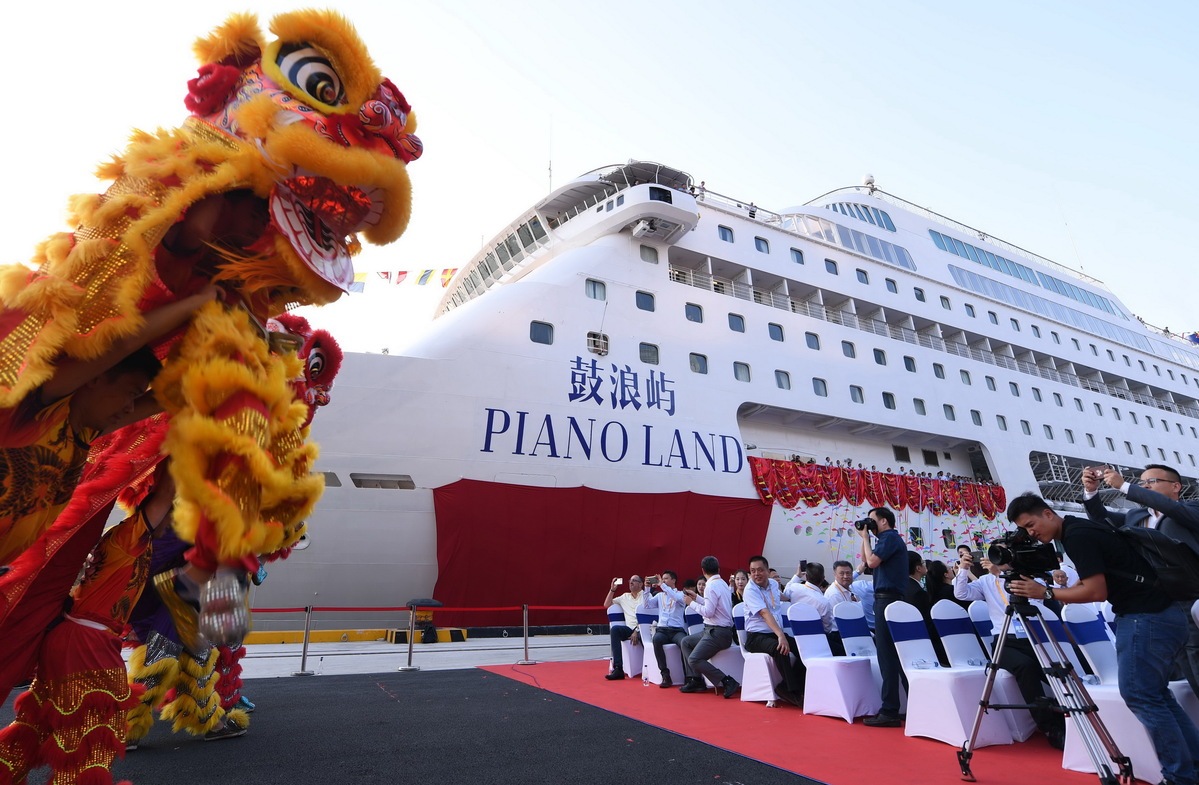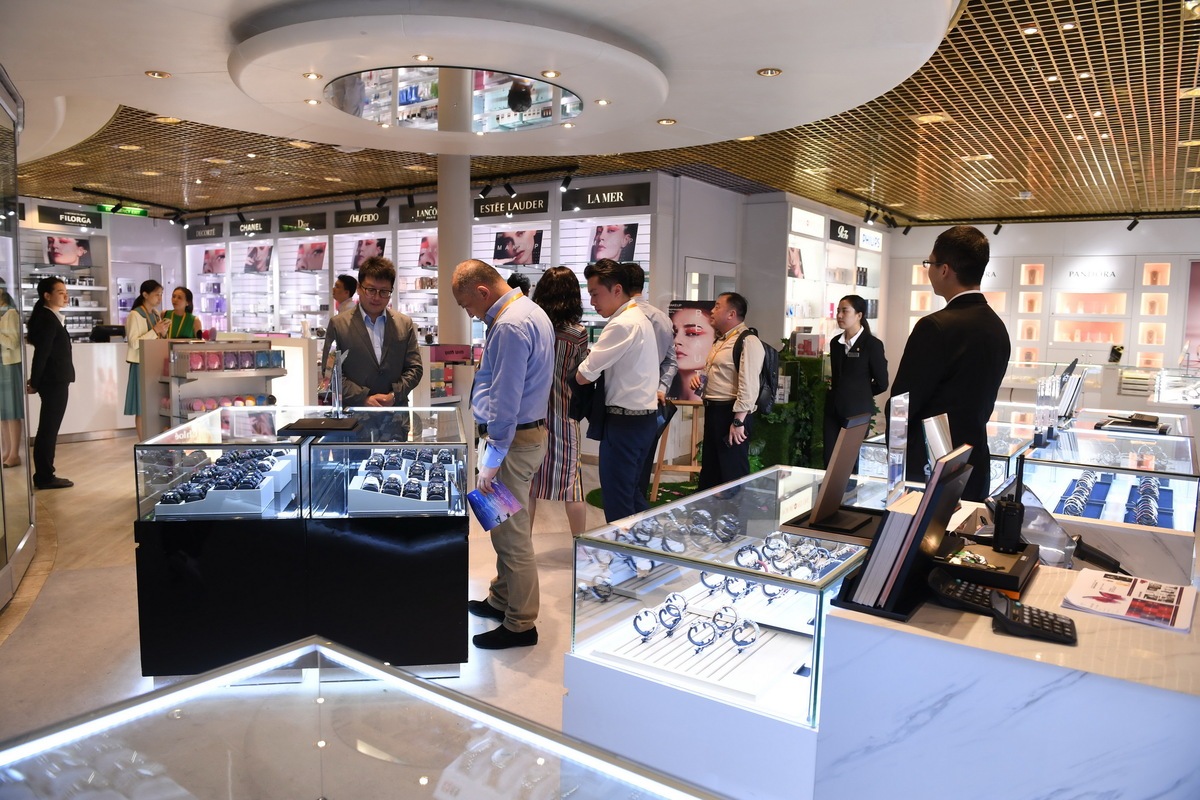
The naming ceremony for Astro Ocean's Piano Land is held at the Xiamen International Cruise Center wharf in Xiamen, Fujian province, in September last year. (Photo: Xinhua)
Chinese leisure liners go full steam ahead, forge JVs, create world-class travel ecosystem
The multibillion-dollar Chinese cruise market is evolving rapidly, and a new vista is on the horizon, promising sustained development, huge investments, jobs and significant economic activity, in line with the ongoing consumption upgrade.
The cruise industry's focus is shifting from being a huge source of experience-minded travelers to becoming home to a world-class business, complete with a comprehensive supply chain.
The cruise industry is confident of riding out what it thinks will be a short-term scare of the novel coronavirus epidemic. The Diamond Princess, a ship of Princess Cruises, was anchored in quarantine off Yokohama port, a city south of Tokyo, last week due to some passengers getting infected.
From private firms to State-owned enterprises to international operators, all are going full steam ahead into the lucrative Chinese market, after an extraordinary decade of growth that saw China's cruise lines emerging as the world's second-largest market by passenger volume.
In the first half of 2019, the nation's 13 cruise ports received 1.78 million passenger trips, an industry report said.
Jointly released by the China Cruise and Yacht Industry Association, which is under the National Development and Reform Commission, the Asia Cruise Academy of Shanghai Maritime University, and the China Ports & Harbors Association, the report said Chinese travelers' enthusiasm for cruise travel is attracting major operators that will likely bring state-of-the-art vessels to the market.
That's not all. Such vessels will offer services and cabins tweaked to cater to Chinese tastes. For, China remains at the forefront as a key source market that also packs in the highest potential. Despite reported slowdown in industry growth in 2018, China dominated with over 55 percent of Asian cruise passengers.
Players already in the industry are expanding their scope and operations to cover specialized fields such as cruise management, besides venturing into big-ticket areas like shipbuilding.
Costa Group Asia is already talking of "building a robust cruise industry ecosystem". Mario Zanetti, president of Costa Group Asia, said: "When it comes to building a cruise industry supply chain in China, Costa Cruises is committed to working with industry stakeholders and creating a sustainable and thriving cruise industry."
Kent Zhu, president of Genting Cruise Lines, expressed similar intent. "With China gearing up to build a complete supply chain, Genting Cruise Lines remains committed to contributing further toward China's growth in the cruise sector, leveraging on its own internal supply chain."
Shanghai Waigaoqiao Shipbuilding Co Ltd, a company controlled by China State Shipbuilding Corporation, kicked off construction of China's first homegrown cruise ship in October 2019.
As China's first self-built cruise ship, the 135,500-metric-ton Vista-class vessel is scheduled for delivery in September 2023. This underscores China's ambition to develop its own shipbuilding capacity in the cruise market, which is dominated by European shipyards, said Wang Yanguo, vice-president of CSSC Cruise Technology Development Co Ltd, a subsidiary of CSSC.
Wikipedia describes a Vista-class ship as one that is "equipped with a diesel-electric power plant and an Azipod propulsion system" and is characterized by "the extensive use of glass in the superstructure". Some 85 percent of a Vista-class ship's staterooms have ocean views and 67 percent have verandas.

Three vessels, including a cruise liner (right), are repaired at a dock of the Zhoushan Changhong International Industrial Park in Zhoushan, Zhejiang province. (Photo for China Daily)
According to Wang, the vessel would be a result of in-depth collaborations between Chinese and international companies.
The construction of the 323.6-meter-long, 37.2-meter-wide and 72.2-meter-high Vista-class cruise ship needs 25 million components and parts, more than 500 direct suppliers and 12 million man-hours of work.
In addition, it would require a number of supporting industries, including maintenance, facilities and equipment, port services, insurance and financial services.
The prospect of huge business is spurring new enterprises and joint ventures. During the 1st China International Import Expo held in Shanghai in November 2018, Costa Cruises' parent company Carnival Corp, the world's largest leisure travel company, teamed up with CSSC to establish a cruise joint venture called CSSC Carnival Cruise Shipping Ltd. Carnival Corp also announced plans to dedicate the first two made-in-China cruise ships to the local market.
Meantime, CSSC-Fincantieri Cruise Industry Development Ltd, a joint venture between CSSC and Italybased Fincantieri SpA, the world's largest cruise shipbuilder, was also formed to work on the design of cruise ships.
"One of the opportunities that we see from upstream supply chain is shipbuilding. China is eager to improve its cruise shipbuilding techniques and Costa is more than willing to share its advanced technology and experience," said Zanetti.
This Costa-CSSC partnership strengthens the local cruise market and could help the latter to become a leader in the global market, he said.
In 2006, Costa Cruises became the first international cruise brand to enter China, and has since witnessed the development of the Chinese cruise industry. It has also driven consumer consumption in related industries.
In the global shipbuilding industry, the segment of large cruise ships is marked by high demand with supply falling short. The gap can potentially harm the sustainable development of the global cruise industry. So, CSSC Cruise Technology Development decided to work on the building of a cruise supply chain ecosystem, Wang said.
Zhou Qi, vice-president of Shanghai Waigaoqiao Shipbuilding, said: "The design and building of cruise ships is a complex and mega systems project that is completely different from the vessels I took part in building over the past two decades."
Wang is confident of bringing the localization rate of the supply chain to about 80 percent by 2030, approaching the level of Fincantieri, Meyer Werft and Chantiers de l'Atlantique (all of whom have a localization rate of more than 80 percent).
"This process will drive the development of a variety of companies home and abroad to set foot in and exploit the Chinese market together," Wang said.
Zanetti of Costa said: "Cruise tourism as an economic agglomeration often requires vertical integration of all related industries besides cruise ships."
Initiated in 2013, China's locally built cruise project by CSSC looks to explore a Chinese cruise industry development model through international collaborations and integration of resources with industry leaders.
"The supply chain of China's cruise industry is being gradually established, from port infrastructure, transportation facilities, shipbuilding and maintenance, to sightseeing, catering and shopping, talent training, and others," said Helen Huang, president of MSC Cruises China.

Tourists visit the duty-free shopping mall on the international luxury liner, the Piano Land. (Photo: Xinhua)
According to Huang, a well-developed supply chain can help deploy different vessels, operate itineraries, cooperate in shipbuilding or maintenance, optimize guest experience and recruit talents. In return, cruise operators have also helped accelerate this process, generating more port fees, taxes, expenditures, crew employment and tourism revenues.
"This approach creates a virtuous cycle, to form an ecosystem connecting upstream and downstream players to better serve the market," she said.
In Shanghai, the Wusongkou Cruise Port of Baoshan district receives more than half of the country's cruise passengers, and after being chosen as the shipbuilding location for the first homegrown cruise vessel, the city is embracing a larger landscape.
CSSC Cruise Technology Development Co Ltd and Shanghai's Baoshan district are working together to build and develop a 2-square-kilometer international cruise industrial park, as well as make Shanghai a globally influential headquarters for the cruise industry.
CSSC Cruise Technology Development looks to invest 50 billion yuan ($7.15 billion) over the next decade and operate a Chinese-funded cruise fleet of between eight and 10 vessels by 2030, said Yang Guobing, its chairman.
Baoshan district is on its way to building an international cruise city and a cruise industry chain entailing 100 billion yuan in investments in the next decade.
"With gradual upgrades of capacity and products, we expect to grow with the whole industry, achieving stable and sustainable development," said Huang.
MSC Cruises established its regional headquarters in Baoshan in 2018, becoming the first international cruise line to locate its regional headquarters in China. On Dec 5 2019, it also signed an agreement with China Merchants Shekou, demonstrating its confidence and commitment to China's cruise market.
Zhu said his Genting Cruise Lines remains highly optimistic as the China market contributes 30 percent of the business with the launch of services of Star Cruises and Dream Cruises in 2019.


